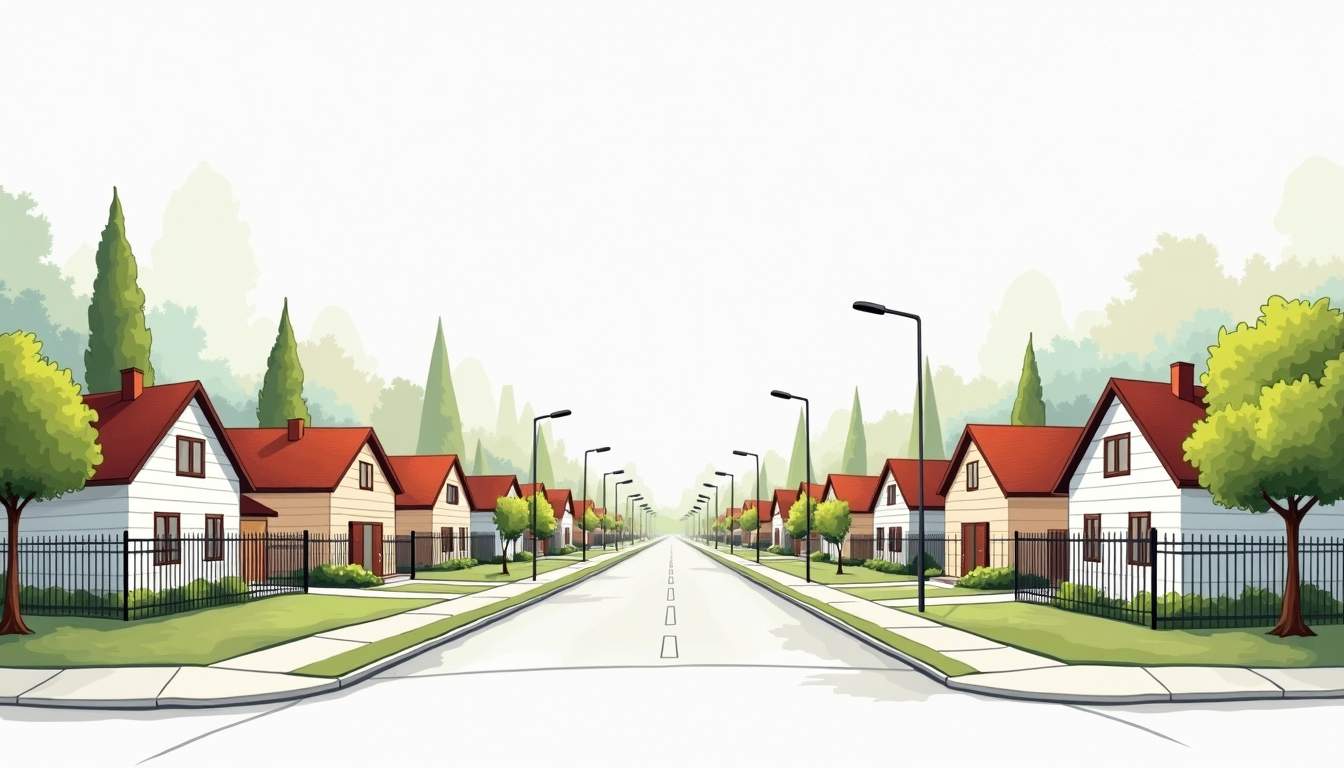
Every family seeks more than a house; the ideal is a neighborhood where children can play safely, where neighbors watch out for each other, and where daily life is supported by dependable services and community spirit. In modern times, the definition of security has broadened beyond locked doors and alarm systems. A truly secure community includes physical safety, emotional well-being, social connection, and reliable infrastructure. The following exploration examines why a secure community matters so much to families today, and what practical steps can foster stronger, more resilient neighborhoods.
Physical safety remains the basic expectation for families. Low crime rates, well-maintained public spaces, good street lighting, and clear traffic controls reduce immediate risks to children and adults alike. When families feel safe walking to school, using parks, and biking to local shops, routines become less stressful and more predictable. Predictability translates into fewer emergency disruptions and more freedom for daily activities like after-school sports, neighborhood gatherings, and evening walks.
Beyond crime prevention, physical safety is tied to urban planning and design choices. Sidewalks that are continuous and wide enough for strollers, crosswalks with visible markings, and traffic-calming measures all reduce the likelihood of accidents. Parks with open sightlines and proper maintenance discourage antisocial behavior and foster continuous use by families. Investment in these elements signals that a community values safety and family life.
Another critical aspect involves community engagement and the presence of local safety initiatives. Neighborhood watch programs, accessible community patrols, and the involvement of residents in safety audits empower families to take part in shaping their environment. These efforts can build trust between families and local authorities, fostering a collective responsibility that goes beyond physical infrastructure. Moreover, the integration of technology, such as well-placed security cameras and emergency call stations, further enhances the sense of security without compromising the openness of public spaces.
Transportation safety also plays a vital role in protecting families. Safe and reliable mass transit options reduce dependence on private vehicles, limiting traffic congestion and exposure to road hazards. Schools situated within walkable distances encourage children to commute independently, but only when routes are secured through pedestrian-friendly design and traffic education programs. Collaborative efforts between school officials, city planners, and families ensure that safety measures meet actual needs, promoting not only protection but also greater autonomy for children and peace of mind for parents.
Child-friendly spaces encourage healthy development and social skills. Playgrounds that offer age-appropriate equipment, safe surfaces, and shade invite children to explore and learn. Creating designated areas for younger and older children prevents collisions and injuries, while seating for caregivers promotes supervision and interaction. When public spaces are intentionally designed for families, participation increases and informal social monitoring grows stronger, which further enhances safety.
Emotional security is about feeling part of a network that cares. Families flourish when neighbors recognize each other, share time and resources, and offer support during life’s unpredictable moments. A community where people greet one another, organize informal childcare swaps, or check in after illness builds a safety net that reduces isolation and stress. These interactions create a sense of belonging that is especially important during transitions—new babies, job changes, or moving into a new home.
Emotional safety also addresses the mental health of parents and children. Access to supportive neighbors can alleviate parental burnout; knowing someone will help in a pinch or lend an empathetic ear lowers chronic stress. Social connection buffers against depression and anxiety for both adults and children, while involvement in school and neighborhood activities strengthens identity and self-esteem for young people.
Trust grows from small, repeated acts: returning a lost item, sharing seasonal produce, or keeping an eye on a house while neighbors are away. Organized efforts like community potlucks, neighborhood newsletters, and local online groups can catalyze relationships, but trust is nurtured in everyday interactions. Prioritizing consistent, respectful communication—such as clear expectations about noise, pets, and shared spaces—limits conflict and reinforces a culture of mutual care.
Economic security at the community level plays a critical role in family stability. Access to reliable services—quality schools, healthcare, childcare, grocery stores, and public transit—reduces the burden of daily logistics and financial strain. When these services are close, affordable, and dependable, families gain precious time and predictability. This stability enables parents to pursue employment or education while ensuring children receive consistent care and learning opportunities.

Local economic health also affects public safety and amenities. Thriving small businesses provide jobs, attract foot traffic, and create informal surveillance that discourages crime. Investment in municipal services—garbage collection, street maintenance, and public lighting—signals that a community is well-managed and safe. Policymakers and civic leaders who prioritize family-oriented services contribute directly to a healthier, more secure environment for residents.
Schools are pillars of community security. High-quality local schools reduce commute times, strengthen social networks among families, and offer extracurricular programs that keep children engaged. Partnerships between schools and community organizations—libraries, recreation centers, and local health clinics—create coordinated supports that address academic and non-academic needs. Ensuring equitable access to education is an important strategy for long-term stability and reduced social disparities within neighborhoods.
Digital safety has become a central component of family security. With children growing up online and families relying on digital tools for banking, healthcare, and communication, cybersecurity and digital literacy matter. Secure home networks, strong passwords, and parental controls help protect privacy and prevent exploitation. Equally important is teaching children critical thinking skills to recognize misinformation, avoid risky online behaviors, and report uncomfortable interactions.

Communities can support digital safety through public workshops, school curricula that incorporate online citizenship, and libraries that provide safe internet access and technology training. Ensuring that vulnerable households have affordable access to devices and broadband reduces the digital divide, giving all families the tools to participate safely in modern life. When digital literacy is shared and promoted at the neighborhood level, families feel more confident navigating online spaces.
Beyond basic cybersecurity practices, protecting family privacy requires attention to the apps and services used daily. Understanding data-sharing practices, adjusting privacy settings, and choosing reputable providers reduce exposure to identity theft and unwanted marketing. Community programs that educate residents about simple safeguards—like two-factor authentication and secure payment methods—help build a baseline of digital resilience across households.
Resilience is the ability to cope with and recover from emergencies—natural disasters, public health events, or localized crises. A secure community plans for such events through coordinated emergency systems, clear communication protocols, and mutual aid networks. Having neighborhood emergency plans, local skill-sharing (first aid, basic repairs), and centralized information hubs lessens panic and speeds recovery. These measures protect family life and reduce long-term disruptions.

Communities that practice preparedness regularly—conducting drills, maintaining emergency kits, and maintaining accessible shelters—demonstrate higher levels of practical security. Inclusivity in planning is crucial; seniors, people with disabilities, and non-English speakers must be part of the conversation to ensure that assistance reaches everyone. Resilience initiatives that emphasize collaboration and shared responsibility strengthen trust and reduce inequalities when crises occur.
Mutual aid networks are an effective expression of community resilience. Organized neighbors who check on vulnerable residents during heat waves, share resources during shortages, or coordinate childcare during emergencies provide immediate, localized support. Volunteerism not only fills gaps in formal services but also deepens social bonds, making communities more adaptable and compassionate when faced with unforeseen challenges.
Creating a secure community requires ongoing effort from residents, local leaders, and institutions. Simple actions include organizing regular neighborhood meetings, supporting local schools and businesses, investing in public infrastructure, and promoting inclusive events that welcome diverse families. Encouraging resident participation in planning and decision-making builds ownership and ensures solutions reflect community needs. Collaboration between civic groups, law enforcement, and social services can align resources and reduce friction.
Policies that prioritize affordable housing, safe public transit, and equitable access to health and education services are long-term investments in security. Grants and public-private partnerships can fund playgrounds, community centers, and street improvements that directly benefit families. At the household level, establishing routines for communication, emergency planning, and neighborly cooperation adds practical layers of safety every day.
Monitoring indicators such as crime rates, school performance, housing stability, and resident satisfaction helps communities adapt strategies over time. Feedback mechanisms—surveys, town halls, and local advisory boards—allow residents to voice concerns and propose solutions. Flexibility is important; as demographics and technologies change, so must the approaches to safety and inclusion. Regular evaluation ensures that efforts remain relevant and effective.
Secure communities are more than a sum of safety measures; they are networks of care that enhance family life, support child development, and foster economic and emotional stability. When neighborhoods invest in physical safety, nurture emotional connections, provide reliable services, promote digital literacy, and prepare for crises, families benefit in ways that extend beyond daily convenience. The ripple effects include healthier children, more resilient adults, stronger local economies, and a richer civic life.
Prioritizing a secure community is an investment in the future—one that yields lifelong returns for children and sets the stage for thriving, connected neighborhoods. Every small action toward building trust, improving infrastructure, or sharing knowledge contributes to a safer environment where families can grow, learn, and flourish together.
Embrace the promise of a secure community that supports your family’s well-being and growth at Tennessee National. Nestled in Tennessee’s stunning landscapes, our premier gated community offers an unmatched blend of physical safety, vibrant social connection, and resort-style amenities designed for family life. From the Greg Norman Signature Golf Course to private marina access and rich member activities, Tennessee National is more than a home—it’s a thriving community. Schedule a private tour today and experience firsthand how secure, luxury living can transform your family’s lifestyle.